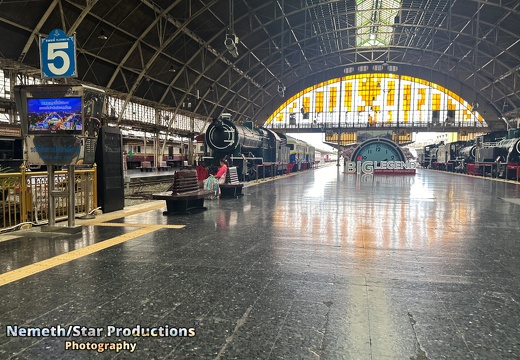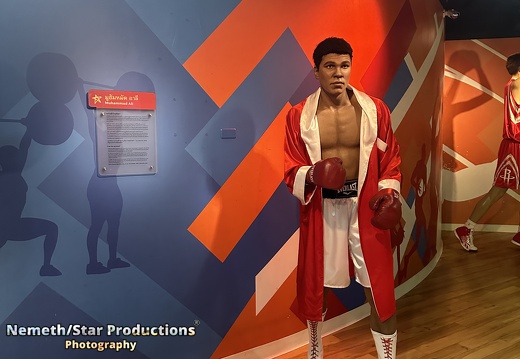
EP01 - Hua Lamphong Train Station
Welcome to "Yim Thong of Thailand: Photography," our captivating new show that transports you directly to the heart of Thailand. Embark on a visual journey with us as we begin our exploration in the vibrant city of Bangkok, starting at the iconic Hua Lamphong train station.
Hua Lamphong railway station, also known as Bangkok railway station, is a significant architectural landmark in Bangkok, Thailand. Designed in Italian neo-Renaissance style by architects Mario Tamagno and Annibale Rigotti, it features decorated wooden roofs, stained glass windows, and grand facades. Completed in 1916 after six years of construction, the station served as a central hub for both goods and passenger transport. Originally named after the nearby Hua Lamphong canal and road, the station’s name reflects its historical context. Some theories suggest that the name originated from the green plains surrounding the area, used for grazing cattle by the Muslim community. Others propose it derived from the Lamphong plant, a toxic species once abundant in the area. During its operation, Hua Lamphong station witnessed significant events, including World War II and the bombing of Bangkok. A large air raid shelter was erected in front of the station during the war, later replaced by the iconic Erawan fountain. Despite its historical significance and architectural charm, the station faced challenges due to limited space for expansion. In 2023, long-distance trains were relocated to the new Krung Thep Aphiwat Central Terminal, marking a shift in the station’s role. Plans to convert Hua Lamphong into a museum were proposed in 2021 but faced opposition. Today, Hua Lamphong railway station continues to serve as a terminus for ordinary and commuter trains, while all Eastern line services terminate there. It remains a symbol of Bangkok’s rich railway history and architectural heritage.

EP02 - Madame Tussauds
Welcome to Madame Tussauds Bangkok, the popular wax figure museum chain situated in the heart of Bangkok, Thailand, within the Siam Discovery shopping complex. Siam Discovery Mall is conveniently connected to the BTS Skytrain and other public transportation options. This is a journey through the world of Asian and Thai celebrities, international movie stars, musicians, political leaders, and sports stars. Experience an incredible journey through the history, sports, entertainment, and glamour of the world. Madame Tussauds is a beloved attraction for both tourists and locals alike. Bangkok’s Madame Tussauds is also a vibrant and diverse exhibition with constantly updated and changing wax figures. Today, you’ll see the exhibition as it was in Bangkok in November 2023.

EP03 - Grand Palace
The Grand Palace in Bangkok, Thailand, has been the official residence of the Kings of Siam since 1782 and continues to be an important venue for official events and ceremonies, despite the royal family living elsewhere since 1925. Comprising numerous buildings, including the Temple of the Emerald Buddha, the palace encompasses various areas such as the Outer, Middle, and Inner Courts. Construction began in 1782 by order of King Phutthayotfa Chulalok (Rama I), with the palace gradually replaced by massive structures over time. The Outer Court houses public buildings and the information center, while the Temple of the Emerald Buddha serves as a royal chapel housing a famous statue.
The groups of buildings Phra Maha Monthien and Phra Maha Prasat form the centerpiece of the Grand Palace, once serving as the residences and throne halls of the kings. Royal coronations since King Rama II have taken place in Phra Maha Monthien, while Phra Maha Prasat houses some of the palace’s oldest structures. During King Rama IV’s reign, a miniature model of Mount Kailasa was constructed for the royal tonsure ceremony, a traditional rite of passage for princes and princesses. Phra Thinang Mahisorn Prasat and Phra Thinang Siwalai Maha Prasat are two other significant complexes within the palace, with the latter built during the reign of King Rama V and now standing empty.
The murals at Phra Rabiang in the Temple of the Emerald Buddha are intricate artworks adorning the walls of the temple’s surrounding gallery walkway. Depicting scenes from the life of the Buddha, Buddhist legends, and mythological stories, these paintings are rich in detail and color, serving both religious teachings and aesthetic beauty. Offering visitors insight into Buddhist culture and history, as well as the artistic grandeur of ancient Thailand.
The Phra Thinang Sitalaphirom, constructed by King Rama VI, is an open pavilion within the Grand Palace used as a resting place and for garden parties. The Phra Buddha Rattanasathan, an ordination hall in the Siwalai Garden, houses a Buddha statue and hosts religious ceremonies. The Museum of the Emerald Buddha Temple, located between the Outer and Middle Courts, displays artifacts from the Grand Palace and temple complex. Originally built as the Royal Mint during King Rama IV’s reign, the two-story building showcases architectural elements of the palace, Buddha statues, Chinese figurines, and items from Thai literature.
As with all public cultural institutions, Thais are allowed to visit for free, while foreigners must pay an entrance fee.









